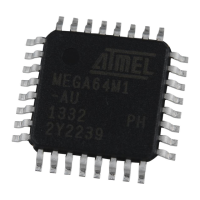165
7647H–AVR–03/12
Atmel ATmega16/32/64/M1/C1
These two bits control the SCK rate of the device configured as a Master. SPR1 and SPR0 have
no effect on the Slave. The relationship between SCK and the clk
IO
frequency f
clkio
is shown in
the following table:
15.2.5 SPI Status Register – SPSR
• Bit 7 – SPIF: SPI Interrupt Flag
When a serial transfer is complete, the SPIF flag is set. An interrupt is generated if SPIE in
SPCR is set and global interrupts are enabled. If SS
is an input and is driven low when the SPI is
in Master mode, this will also set the SPIF flag. SPIF is cleared by hardware when executing the
corresponding interrupt handling vector. Alternatively, the SPIF bit is cleared by first reading the
SPI Status Register with SPIF set, then accessing the SPI Data Register (SPDR).
• Bit 6 – WCOL: Write COLlision Flag
The WCOL bit is set if the SPI Data Register (SPDR) is written during a data transfer. The
WCOL bit (and the SPIF bit) are cleared by first reading the SPI Status Register with WCOL set,
and then accessing the SPI Data Register.
• Bit 5..1 – Res: Reserved Bits
These bits are reserved bits in the ATmega16/32/64/M1/C1 and will always read as zero.
• Bit 0 – SPI2X: Double SPI Speed Bit
When this bit is written logic one the SPI speed (SCK Frequency) will be doubled when the SPI
is in Master mode (see Table 15-4). This means that the minimum SCK period will be two CPU
clock periods. When the SPI is configured as Slave, the SPI is only guaranteed to work at f
clkio
/4
or lower.
The SPI interface on the ATmega16/32/64/M1/C1 is also used for program memory and
EEPROM downloading or uploading. See Serial Programming Algorithm313 for serial program-
ming and verification.
Table 15-4. Relationship Between SCK and the Oscillator Frequency
SPI2X SPR1 SPR0 SCK Frequency
000
f
clkio
/4
001
f
clkio
/16
010f
clkio
/64
011f
clkio
/128
100
f
clkio
/2
101f
clkio
/8
110f
clkio
/32
111
f
clkio
/64
Bit 76543210
SPIF WCOL – – – – – SPI2X SPSR
Read/Write R R R R R R R R/W
Initial Value 00000000

